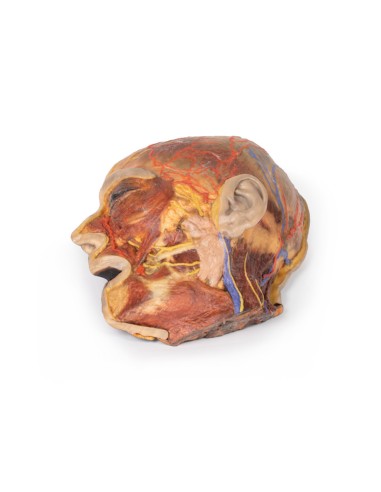Superficial facial nerves and parotid gland - Erler Zimmer 3D anatomy Series MP1109
erler zimmerMade in ultra-high resolution 3D printing in full color.
Superficial facial nerves and parotid gland - Erler Zimmer 3D anatomy Series MP1109
This model is part of the exclusive Monash 3D anatomy series, a comprehensive series of human dissections reproduced with ultra-high resolution color 3D printing.
This 3D model presents the superficial anatomy of the face and head and complements the superficial facial anatomy of our HW 44 model with a more extensive dissection through the scalp and occipital regions.
The superficial neurovascular and muscular structures of the face largely mirror those described in reference to our HW 44 specimen (see description), although the terminal branches of the facial nerve (CNVII) can be extensively followed through a longer course from the parotid gland, and the platysma muscle was kept superficial to the mandible and extends toward the neck.
Unlike sample HW 44, this model has a broader superficial dissection below the outer ear and through the posterior scalp and occipital region. This allows an expanded appreciation of the neurovascular distribution of the supraorbital and supratrochlear nerves and limbs with the superficial temporal artery. Inferior to the ear, the retromandibular vein was exposed with ascending fibers of the great auricular nerve on its superficial surface (and additional branches of this nerve on the surface of the sternocleidomastoid muscle). At the posterior margin of the sternocleidomastoid muscle the lesser occipital nerve is just preserved, near the exit and ascension of the occipital artery and vein near the trapezius muscle to the posterior scalp. Around the outer ear are the fibers of the superior and posterior auricular muscles. Near the edge of the dissection window posteriorly, the deep fibers of the occiptalis muscle integrated into the epicranium (occipitofrontal) muscle can be seen.
What advantages does the Monash University anatomical dissection collection offer over plastic models or plastinated human specimens?
- Each body replica has been carefully created from selected patient X-ray data or human cadaver specimens selected by a highly trained team of anatomists at the Monash University Center for Human Anatomy Education to illustrate a range of clinically important areas of anatomy with a quality and fidelity that cannot be achieved with conventional anatomical models-this is real anatomy, not stylized anatomy.
- Each body replica has been rigorously checked by a team of highly trained anatomists at the Center for Human Anatomy Education, Monash University, to ensure the anatomical accuracy of the final product.
- The body replicas are not real human tissue and therefore not subject to any barriers of transportation, import, or use in educational facilities that do not hold an anatomy license. The Monash 3D Anatomy dissection series avoids these and other ethical issues that are raised when dealing with plastinated human remains.
















